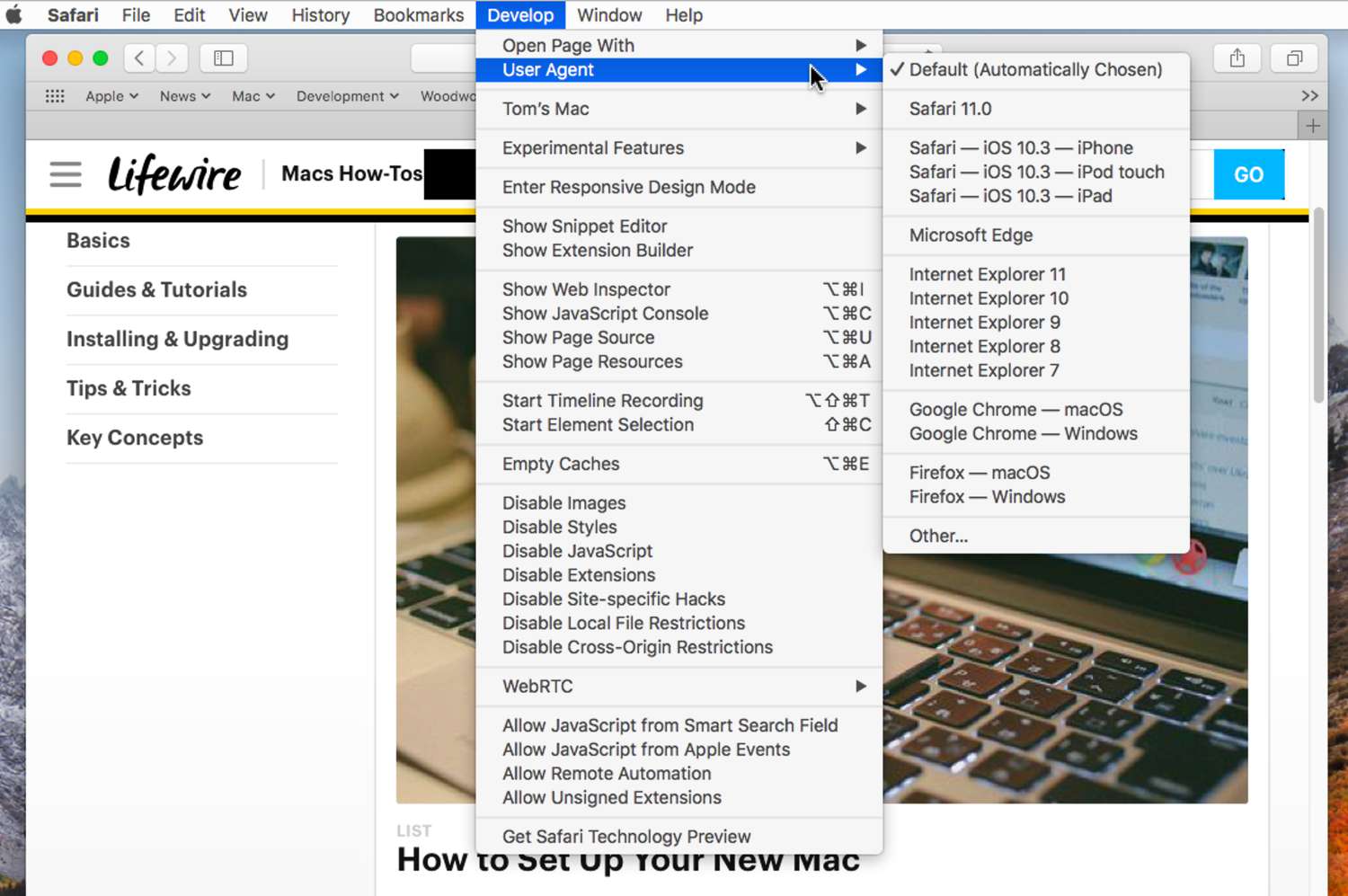Introduction
Safari is a powerful and versatile web browser that comes pre-installed on Mac computers, offering a seamless and intuitive browsing experience. However, over time, you may encounter issues such as slow performance, unresponsive tabs, or unexpected crashes. When these issues arise, it may be time to refresh Safari to optimize its performance and ensure a smooth browsing experience.
Refreshing Safari involves clearing browsing data, disabling extensions, and updating the browser to the latest version. This process can help resolve various issues, including sluggishness, frequent crashes, and unresponsiveness. By following a few simple steps, you can refresh Safari and enjoy a faster, more reliable browsing experience on your Mac.
In this guide, we will walk you through the process of refreshing Safari on your Mac, providing step-by-step instructions to help you optimize the browser's performance. Whether you're a seasoned Mac user or new to the platform, these straightforward steps will enable you to refresh Safari and address common browsing issues effectively.
By taking the time to refresh Safari, you can enhance its stability, speed, and overall functionality, ensuring that you can browse the web with ease and confidence. So, let's dive into the steps and revitalize your Safari browsing experience on your Mac.
Step 1: Open Safari
To begin the process of refreshing Safari on your Mac, you'll first need to open the Safari browser. Safari is typically located in the Dock at the bottom of the screen, making it easily accessible. Alternatively, you can find it in the Applications folder within Finder. Once you've located the Safari icon, simply click on it to launch the browser.
Upon opening Safari, you'll be greeted by the familiar interface, featuring the address bar, bookmarks, and various navigation tools. If Safari was previously open, it will resume from where you left off, displaying any tabs or windows that were active during your last browsing session.
Opening Safari is the initial step in the process of refreshing the browser, setting the stage for the subsequent actions that will help optimize its performance. By ensuring that Safari is up and running, you can proceed to the next steps, which involve clearing browsing data, disabling extensions, and updating the browser to the latest version.
As you open Safari, take a moment to familiarize yourself with the browser's layout and features. This will enable you to navigate through the subsequent steps more efficiently, ensuring that you can address any browsing issues effectively. Whether you use Safari for casual web browsing, research, or work-related tasks, having a clear understanding of its interface will be beneficial as you proceed with the process of refreshing the browser.
With Safari now open on your Mac, you're ready to move on to the next step, which involves clearing browsing data to eliminate unnecessary clutter and optimize the browser's performance. This step is crucial in refreshing Safari and addressing common issues such as slow loading times and unresponsive tabs. By following the subsequent steps, you'll be able to revitalize Safari and enjoy a smoother, more efficient browsing experience on your Mac.
Step 2: Clear Browsing Data
Clearing browsing data is an essential step in refreshing Safari on your Mac. Over time, Safari accumulates temporary files, cookies, and browsing history, which can contribute to sluggish performance and unexpected behavior. By clearing this data, you can eliminate unnecessary clutter and optimize the browser's performance, resulting in faster loading times and improved responsiveness.
To clear browsing data in Safari, follow these simple steps:
-
Open Safari Preferences: Click on "Safari" in the top menu bar and select "Preferences." Alternatively, you can use the keyboard shortcut "Command + ," to access Safari Preferences.
-
Navigate to the Privacy Tab: Within the Preferences window, click on the "Privacy" tab. Here, you'll find various options related to managing website data, cookies, and other browsing information.
-
Manage Website Data: To clear website data, click on the "Manage Website Data" button. This will display a list of websites that have stored data on your Mac. You can choose to remove individual website data or click "Remove All" to clear all stored data.
-
Manage Cookies and Website Data: In the Privacy tab, you can also manage cookies and website data. Click on the "Manage Website Data" button to view and remove stored cookies and website data.
-
Clear History: To clear your browsing history, navigate to the "History" tab within Safari Preferences. Click on "Clear History" and select the desired time range for which you want to clear the history. You can choose to clear the history from the last hour, today, today and yesterday, or all history.
By following these steps, you can effectively clear browsing data in Safari, decluttering the browser and optimizing its performance. This process helps remove unnecessary files and data that may be contributing to slow loading times, unresponsive tabs, and other browsing issues. Once you've cleared the browsing data, you're ready to proceed to the next step in refreshing Safari on your Mac.
Clearing browsing data is a proactive measure to maintain Safari's efficiency and ensure a seamless browsing experience. By regularly clearing browsing data, you can prevent the accumulation of unnecessary files and data, thereby optimizing Safari's performance and responsiveness. With the browsing data cleared, you're now prepared to move on to the next steps, including disabling extensions and updating Safari to the latest version, further enhancing the browser's functionality and stability.
Step 3: Disable Extensions
Disabling extensions is a crucial step in the process of refreshing Safari on your Mac. Browser extensions, also known as add-ons or plugins, are additional software components that enhance the functionality of the browser by adding features and customization options. While extensions can be valuable tools for improving productivity and enhancing the browsing experience, they can also contribute to performance issues and unexpected behavior in Safari.
To disable extensions in Safari, follow these steps:
-
Open Safari Preferences: Click on "Safari" in the top menu bar and select "Preferences." Alternatively, you can use the keyboard shortcut "Command + ," to access Safari Preferences.
-
Navigate to the Extensions Tab: Within the Preferences window, click on the "Extensions" tab. Here, you'll find a list of installed extensions, each accompanied by a checkbox to enable or disable the extension.
-
Disable Extensions: To disable an extension, simply uncheck the box next to the extension's name. This action effectively disables the extension, preventing it from running and impacting Safari's performance.
-
Remove Unnecessary Extensions: While in the Extensions tab, take the opportunity to review the list of installed extensions. If there are any unnecessary or unused extensions, consider removing them entirely by clicking on the extension and selecting "Uninstall."
Disabling extensions in Safari can help address various browsing issues, including slow performance, frequent crashes, and compatibility issues. By temporarily disabling extensions, you can assess their impact on Safari's performance and determine whether they are contributing to any issues you may be experiencing.
Additionally, disabling extensions can serve as a troubleshooting step, allowing you to identify specific extensions that may be causing problems. By systematically disabling extensions and observing Safari's behavior, you can pinpoint any problematic extensions and take appropriate action to resolve the issues.
Once you have disabled or removed unnecessary extensions, you can proceed to the next step in refreshing Safari, which involves updating the browser to the latest version. This ensures that Safari benefits from the latest features, security enhancements, and performance optimizations, further improving its functionality and stability.
By disabling extensions in Safari, you can streamline the browser's operation, mitigate potential performance issues, and create a more reliable browsing environment on your Mac. This proactive approach to managing extensions can contribute to a smoother and more efficient browsing experience, allowing you to make the most of Safari's capabilities while minimizing potential disruptions.
Step 4: Update Safari
Updating Safari to the latest version is a pivotal step in the process of refreshing the browser on your Mac. Regular updates not only introduce new features and enhancements but also address security vulnerabilities and performance issues, ensuring that Safari operates at its best. By keeping Safari up to date, you can benefit from improved stability, compatibility with web standards, and enhanced browsing security.
To update Safari on your Mac, follow these straightforward steps:
-
Check for Updates: Launch Safari and click on "Safari" in the top menu bar. From the drop-down menu, select "About Safari." A window will appear, indicating the current version of Safari installed on your Mac. Next to the version number, there will be an option to "Check for Updates." Click on this option to initiate the update process.
-
Install Available Updates: If a new version of Safari is available, you will be prompted to install the update. Follow the on-screen instructions to proceed with the installation. Depending on your Mac's settings, you may need to enter your administrator password to authorize the update.
-
Restart Safari: Once the update is successfully installed, restart Safari to apply the changes. This ensures that the latest version of Safari is active and ready for use.
By updating Safari to the latest version, you can take advantage of performance optimizations, bug fixes, and security patches released by Apple. These updates not only enhance the browsing experience but also contribute to a more secure and reliable web environment on your Mac.
In addition to updating Safari itself, it's important to ensure that your Mac's operating system is also up to date. Safari updates are often bundled with macOS updates, so keeping your Mac's operating system current is essential for maintaining the overall performance and security of Safari.
Regularly checking for and installing Safari updates is a proactive measure that helps mitigate potential browsing issues and ensures that you have access to the latest features and improvements. By incorporating the habit of updating Safari into your routine, you can optimize the browser's performance and enjoy a seamless browsing experience on your Mac.
With Safari now updated to the latest version, you're ready to proceed to the final step in refreshing the browser, which involves restarting Safari to apply the changes and ensure that the updates take effect. This last step will complete the process of refreshing Safari on your Mac, allowing you to enjoy an optimized and reliable browsing experience.
Step 5: Restart Safari
Restarting Safari is the final step in the process of refreshing the browser on your Mac. After completing the previous steps, including clearing browsing data, disabling extensions, and updating Safari to the latest version, restarting the browser is essential to ensure that the changes take effect and that Safari operates optimally.
To restart Safari, follow these simple steps:
-
Close Safari: If Safari is currently open, click on the Safari menu in the top menu bar and select "Quit Safari." Alternatively, you can use the keyboard shortcut Command + Q to close the browser. This action ensures that Safari completely shuts down, allowing for a fresh start when it is relaunched.
-
Relaunch Safari: After closing Safari, click on the Safari icon in the Dock or open it from the Applications folder. As Safari launches, it will initialize with the recent changes and optimizations applied during the refreshing process. You may notice improved responsiveness, faster loading times, and overall enhanced performance as Safari restarts with the updated settings and configurations.
By restarting Safari, you allow the browser to reset its state and apply the modifications made during the refreshing process. This ensures that any lingering issues or performance bottlenecks are addressed, providing you with a revitalized and reliable browsing experience on your Mac.
Additionally, restarting Safari serves as a proactive measure to clear temporary data and refresh the browser's operation, contributing to a smoother and more efficient browsing environment. It allows Safari to start afresh, incorporating the benefits of the previous steps and ensuring that the browser operates at its best.
As Safari restarts, take a moment to navigate through your favorite websites and web applications, observing the improvements in performance and responsiveness. You may notice that tabs load more quickly, browsing history is cleared, and any problematic extensions are effectively managed, resulting in a more seamless and enjoyable browsing experience.
With Safari successfully restarted, you have completed the process of refreshing the browser on your Mac. By following these steps, you have optimized Safari's performance, addressed common browsing issues, and created a more reliable and efficient web browsing environment. Whether you use Safari for work, research, or leisure, restarting the browser ensures that you can make the most of its capabilities and enjoy a seamless browsing experience on your Mac.

























